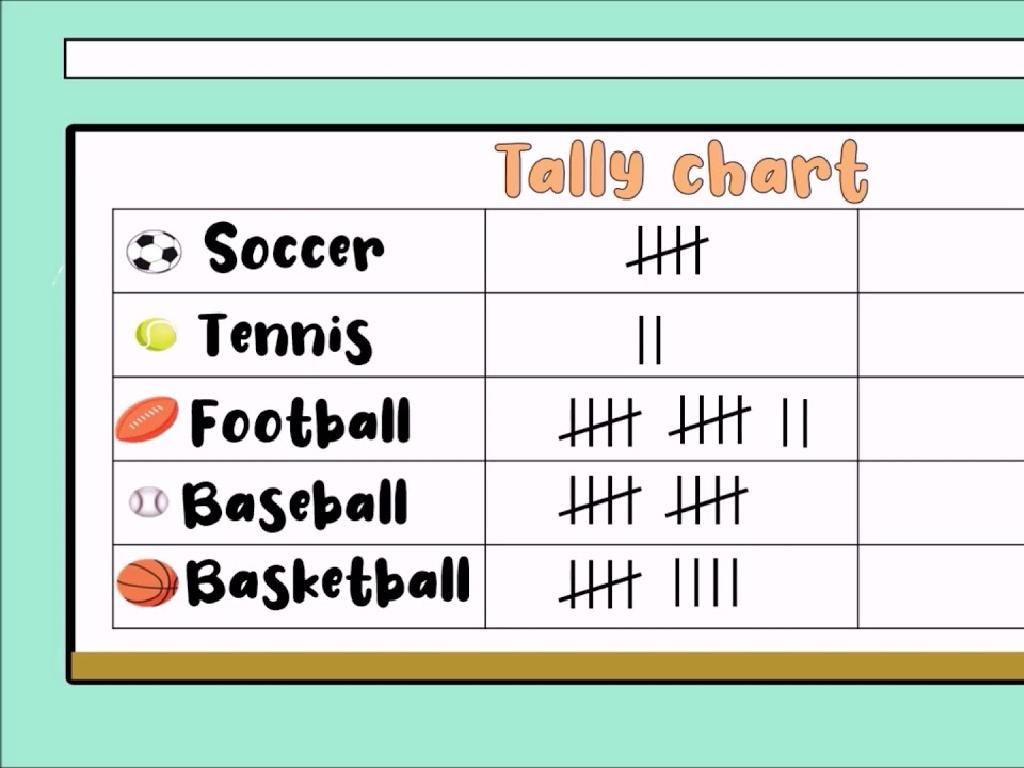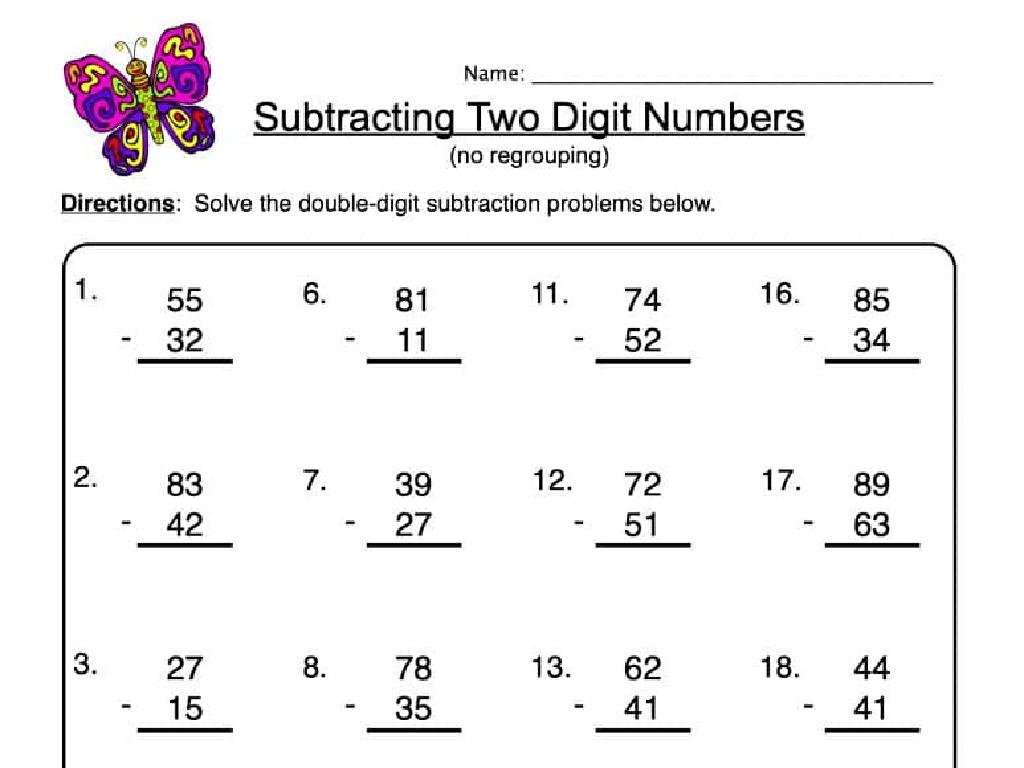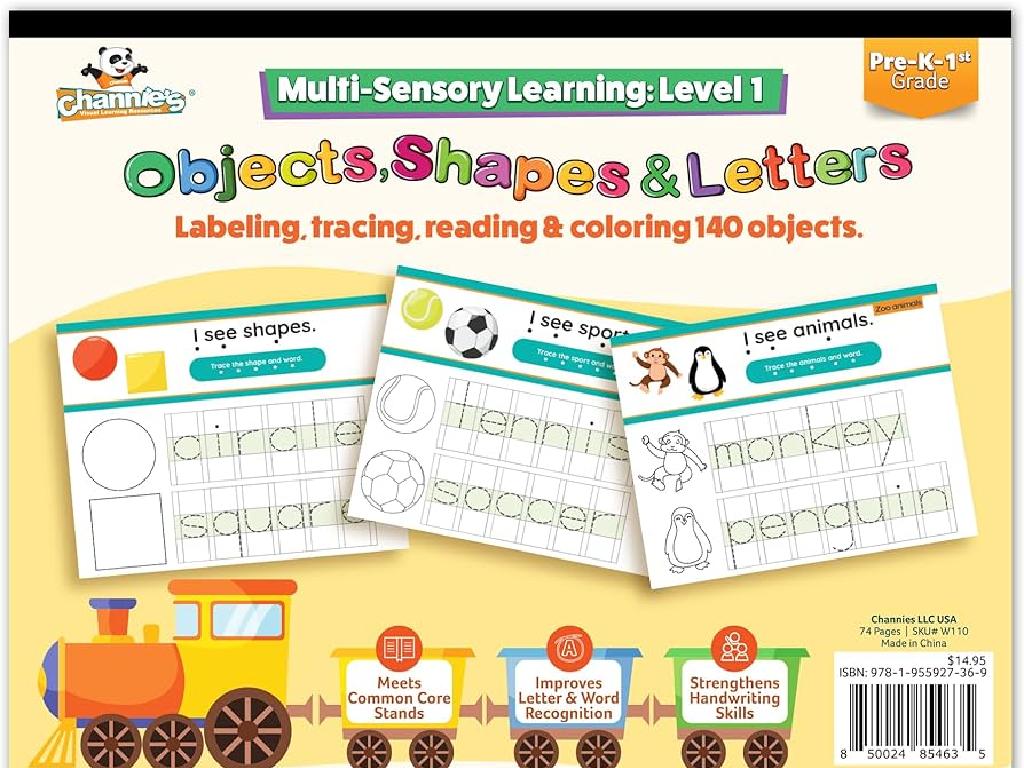Subtracting 8
Subject: Math
Grade: First grade
Topic: Subtraction Up To 20
Summary: This engaging first grade math lesson teaches how to subtract 8 from numbers up to 20 using real-life examples, fingers, counters, and number lines. Students practice subtraction with interactive activities, games, and worksheets designed for hands-on learning. The lesson reinforces subtraction as 'taking away', builds confidence, and encourages students to visualize and count what remains. Fun games like Race to Zero make mastering subtraction skills enjoyable and memorable for young learners.
Please LOG IN to download the presentation. Access is available to registered users only.
View More Content
Welcome to Subtraction!
– Greetings and subtraction intro
– Understanding ‘taking away’
– Imagine you have 10 apples and you give away 8.
– Subtraction shows what’s left
– If you start with 15 blocks and 8 are taken away, how many do you have?
– Practice with subtracting 8
– We’ll do examples together to learn!
|
Begin the class with a warm welcome and an introduction to subtraction as a concept of ‘taking away’. Explain that subtraction helps us figure out the number of items remaining after some have been removed. Use tangible examples like apples or blocks to illustrate this point. For instance, if a student has a certain number of items and some are taken away, how many are left? This will help them visualize the process. During the class, provide various examples of subtracting 8 from different numbers up to 20, and encourage the students to solve them together. This interactive approach will help solidify their understanding of subtraction.
Understanding Subtraction: Taking Away
– Subtraction means taking away
– Finding out how many left
– If we start with 10 toys and give away 2, how many do we have?
– Example with apples
– Imagine having 8 apples and eating 2, count how many are left.
– Practice subtracting 8
– Let’s try with numbers: 15 – 8, 12 – 8, what are the answers?
|
This slide introduces the concept of subtraction to first graders by relating it to a simple real-life scenario of having a certain number of items and then taking some away. The apple example is a tangible way for students to visualize the concept. Encourage the students to use their fingers or counters to subtract 8 from different numbers up to 20. This will help them understand that subtraction is the process of finding out the remaining quantity after some has been taken away. The slide sets the foundation for a subtraction activity where students can practice with various numbers, solidifying their understanding of the concept.
Subtracting 8: Learning to Take Away
– Practice subtracting 8 from numbers
– Imagine 10 fingers, put 8 away
– If 8 fingers are in our pockets, we count the ones outside.
– Use fingers or counters for help
– Counting physical objects like fingers or counters can make subtracting easier.
– Drawing pictures to understand subtraction
– Visual aids like drawings can help us see what subtracting 8 looks like.
|
This slide is aimed at helping first graders understand the concept of subtraction by taking away 8 from different numbers. Encourage the students to use their fingers as a counting tool, which is relatable and easily accessible. For example, if they start with 10 fingers and hide 8, they can easily see how many are left. Additionally, using counters or drawing pictures can provide a visual representation of the subtraction process, making it more tangible for young learners. During the class, engage the students in activities where they can practice this with different numbers, ensuring they grasp the concept of ‘taking away’ and how the total number decreases.
Let’s Try Together: Subtracting 8
– Use a number line for subtraction
– Start at 15, jump back 8 spaces
– Starting at 15, hop backwards 1 space at a time, 8 times
– Find where we land
– The number you land on is the answer
– Count how many are left
– After 8 jumps, count the remaining spaces to 0
|
This slide is an interactive class activity designed to teach first graders how to subtract 8 from a given number using a number line. Start by explaining the concept of a number line and how it can be used as a tool for subtraction. Demonstrate with the whole class by starting at the number 15 on the number line and physically moving back 8 spaces. Ask the students to observe where you land and to determine the result of 15 minus 8. Encourage the students to use their fingers to count as they move back each space. This visual and physical activity helps solidify the concept of subtraction by making it a tangible process. For the activity, provide each student with their own number line and have them practice subtracting 8 from different numbers up to 20. Offer guidance and support as needed.
Subtracting 8 from Numbers
– Subtract 8 from 16
– 16 – 8 equals what number?
– Subtract 8 from 18
– 18 – 8 equals what number?
– Subtract 8 from 20
– 20 – 8 equals what number?
– Count backwards to subtract
– Use fingers or objects to help count back
|
This slide is designed to help first graders practice the concept of subtraction by subtracting 8 from various numbers. Start by demonstrating how to subtract 8 from 16, 18, and 20 on the board. Encourage students to use their fingers, drawings, or physical counters like blocks or beads to help them visualize the subtraction process. Remind them to count backwards carefully from the number they are subtracting from. For example, if subtracting 8 from 16, they would count backwards from 16 until they reach 8. Reinforce the concept by having students practice with different numbers and use various methods to find the answer. This hands-on approach will help solidify their understanding of subtraction.
Practice Time: Subtracting 8
– Try subtraction problems on your own
– We’ll solve worksheets together
– Use the worksheets to practice subtracting 8 from numbers up to 20
– Mistakes help us learn
– Remember, it’s okay to make mistakes. That’s how we get better!
– Have fun with numbers!
|
This slide is designed to encourage students to actively engage in practicing subtraction by subtracting 8 from various numbers up to 20. The activity should be presented as a fun and interactive learning experience. Provide worksheets with subtraction problems for the students to solve. As they work through the problems, remind them that making mistakes is a natural part of the learning process and that each mistake is an opportunity to improve. Walk around the classroom to offer support and guidance. Possible activities could include using manipulatives like counters or number lines, subtraction games, or pairing students up for peer learning. The goal is to build confidence and proficiency in subtraction.
Subtraction Game: Race to Zero!
– Play with dice to learn subtraction
– Start at 20, roll dice and subtract
– If you roll an 8, what is 20 minus 8?
– First to exactly zero is the winner
– Have fun while practicing math!
– Remember, subtraction is taking away!
|
This interactive game is designed to help first graders practice subtracting numbers up to 8 from 20. Each student will take turns rolling a dice. When they roll, they will subtract the number they get from 20. The goal is to reach exactly zero. If a student goes below zero, they must try again on their next turn. This game reinforces the concept of subtraction as ‘taking away’ and provides a fun and engaging way for students to become more comfortable with math. Possible variations of the activity include using different starting numbers or pairing students to play in teams. Encourage students to use their fingers or number lines if they need help subtracting.
Review and Goodbye: Subtracting 8
– What is subtraction?
– Subtracting means taking away
– Like if we have 10 apples and eat 2, we have 8 left
– Counting what’s left after subtracting
– If we start with 15 toys and give away 8, we count how many we have now
– Great work and see you soon!
|
Today’s lesson focused on understanding the concept of subtraction as taking away from a group and finding out how many items remain. Reinforce the idea that subtraction is not just about memorizing facts, but about visualizing the action of removing items and counting what’s left. Praise the students for their hard work and encourage them to practice with different numbers at home. Remind them that subtraction is a part of everyday life and they did a great job learning today. Let them know you’re excited to see them in the next class and to continue exploring math together.





